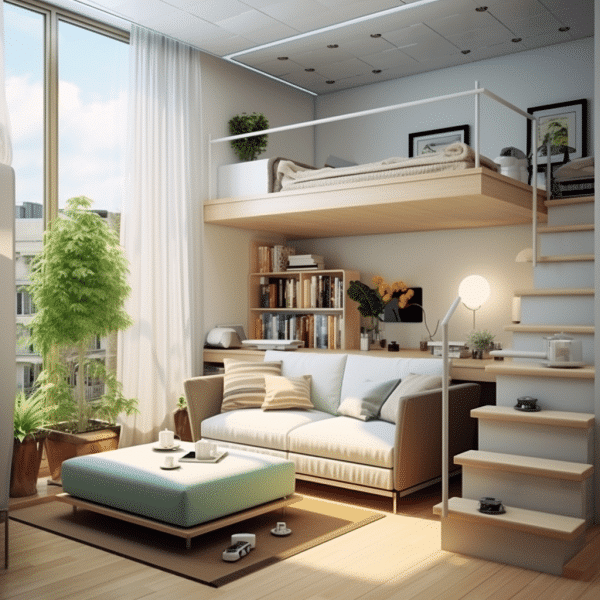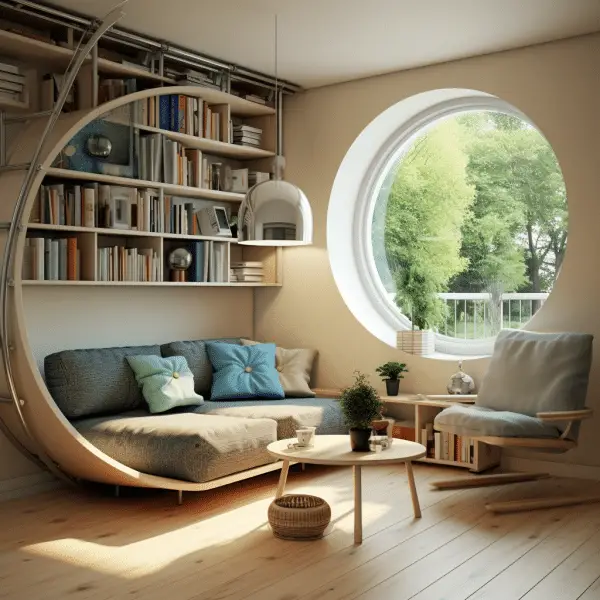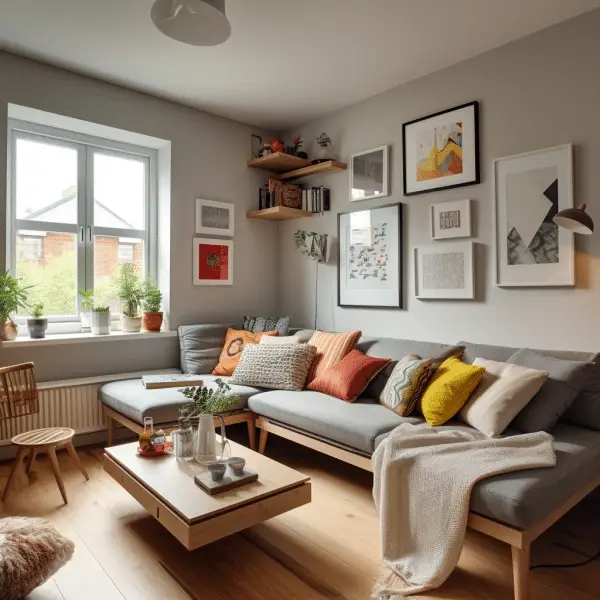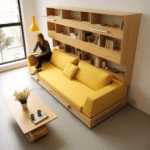Small Living Room Space: Lack of space can be a big problem in small living rooms, but there are plenty of tips and tricks you can use to create the illusion of a larger space. From choosing the right colors to arranging furniture strategically, there are many ways to maximize your living room’s potential. By simplifying your color scheme, using mirrors, and opting for appropriately proportioned furniture, you can make your small living room feel more spacious. Lighting techniques, such as utilizing natural light and incorporating multiple light sources, can also help create the illusion of a larger space. Additionally, making use of vertical space with shelves and artwork, and choosing furniture with legs or clear acrylic materials can further enhance the sense of openness in your small living room.
Table of Contents
Key Takeaways:
- Choose a light and neutral color scheme to create the illusion of space.
- Use mirrors strategically to reflect light and make the room feel brighter.
- Maximize natural light by avoiding heavy curtains and using lightweight window treatments.
- Arrange furniture away from the walls and create clear walkways to create an airy feel.
- Opt for appropriately proportioned and multifunctional furniture to save space and improve functionality.
Simplify Your Color Scheme
Choosing the right color scheme can make a significant difference in how spacious a small living room feels. While using light and neutral colors is a popular technique to create the illusion of space, there are other options to consider.
One effective approach is color drenching, which involves using the same color in different shades throughout the room. This technique creates a seamless and spacious look, as the varying shades blend together harmoniously. Lighter shades tend to reflect natural light and open up the space, while darker neutrals can add depth and create a cozy atmosphere.
However, it’s important to avoid an overload of bold or dark colors, as they can make the room feel smaller and disjointed. Instead, opt for a balanced color palette that incorporates a mix of light and neutral tones. By simplifying your color scheme and choosing a cohesive range of shades, you can create a visually appealing and spacious environment in your small living room.
Key Tips for Simplifying Your Color Scheme:
- Choose light and neutral colors to create a sense of openness.
- Consider color drenching by using the same color in different shades.
- Avoid overwhelming the room with bold or dark colors.
- Opt for a balanced color palette that reflects your personal style.
Table: Examples of Color Schemes for Small Living Rooms
| Color Scheme | Description |
|---|---|
| Monochromatic | Using different shades of the same color creates a cohesive and spacious look. |
| Light Neutrals with Accents | Pairing light neutrals, such as beige or off-white, with pops of color adds visual interest while maintaining a sense of openness. |
| Earth Tones | Using warm earthy colors, such as browns and greens, can create a grounded and cozy atmosphere in a small living room. |
Use Mirrors and Lighting Techniques
Mirrors are a classic trick to make a small living room look bigger. Placing mirrors strategically can create the illusion of more square footage and reflect light, making the room feel brighter and more spacious. It’s best to opt for large mirrors to maximize their impact.
In addition to using mirrors, utilizing proper lighting techniques can also enhance the perception of space. Natural light should be maximized by avoiding heavy curtains and making use of lightweight window treatments. Incorporating multiple light sources, such as floor and table lamps, can create a layered and well-lit space that gives the impression of a larger room.
“Mirrors are like windows that never close, they can add depth and visual interest to any small space.” – Interior Design Expert
Lighting Techniques for Small Living Rooms
- Maximize natural light by keeping windows clear of obstructions
- Use sheer curtains or blinds to let in more light
- Incorporate different types of light sources, such as overhead, task, and accent lighting
- Choose light fixtures with open designs or glass shades to avoid blocking light
- Consider installing dimmer switches to control the intensity of light
Tricks to Create an Illusion of Space with Mirrors
- Place mirrors opposite windows or other light sources to reflect light
- Hang a large mirror on one wall to create the illusion of a larger room
- Create a gallery wall of small mirrors for a unique and visually appealing look
- Position mirrors behind furniture to make the room appear more open
By strategically using mirrors and lighting techniques, you can transform your small living room into a more spacious and inviting space. These simple tricks can make a big difference in the overall look and feel of your room, giving the illusion of more square footage and improving the overall ambiance.
| Lighting Techniques | Mirror Tricks |
|---|---|
| Maximize natural light | Place mirrors opposite windows |
| Use sheer curtains | Hang a large mirror on one wall |
| Incorporate multiple light sources | Create a gallery wall of small mirrors |
| Choose open light fixtures | Position mirrors behind furniture |
| Install dimmer switches |
Arrange Furniture Strategically
When it comes to making the most of a small living room, proper furniture arrangement is key. By strategically placing your furniture, you can create the illusion of a larger space and optimize the available square footage. Here are some space-saving ideas and furniture arrangement tips for small living rooms.
Firstly, instead of pushing all your furniture against the walls, try bringing some pieces away from the walls. This can help create a more open and airy feel in the room. By creating clear walkways and leaving breathing space between furniture pieces, you can make the room appear more spacious. Instead of pushing all the furniture against the walls, consider bringing some pieces away from the walls to create the illusion of airiness. It’s important to create clear walkways and leave some breathing space in the room. Additionally, choosing appropriately proportioned furniture is crucial in maximizing the available space. Using multifunctional furniture can also help save space and improve functionality.
Secondly, be mindful of the size and scale of your furniture. Avoid cluttering the room with oversized or bulky pieces, as they can overpower the space and make it feel cramped. Opt for slim and compact furniture that fits well within the constraints of a small living room. Consider using multifunctional furniture, like a sofa with built-in storage or a coffee table that folds up, to maximize both functionality and space.
Remember, the key to arranging furniture in a small living room is to prioritize open space and flow. By following these space-saving ideas and considering the scale of your furniture, you can create a comfortable and visually appealing living space, even in a small room.
FAQ
How can I make a small living room look bigger?
There are several tips and tricks you can use to create the illusion of a larger space in a small living room. From choosing the right colors to arranging furniture strategically, there are many ways to maximize your living room’s potential.
What color scheme should I use in a small living room?
While using light and neutral colors is a popular technique to create the illusion of space, there are other options to consider. Color drenching, which involves using the same color in different shades throughout the room, can create a seamless and spacious look. Lighter shades tend to reflect natural light and open up the space, while darker neutrals can add depth and create a cozy atmosphere.
How can mirrors and lighting techniques help make a small living room look bigger?
Mirrors are a classic trick to make a small living room look bigger. Placing mirrors strategically can create the illusion of more square footage and reflect light, making the room feel brighter and more spacious. Utilizing proper lighting techniques, such as maximizing natural light and incorporating multiple light sources, can also enhance the perception of space.
How should I arrange furniture in a small living room?
Instead of pushing all the furniture against the walls, consider bringing some pieces away from the walls to create the illusion of airiness. It’s important to create clear walkways and leave some breathing space in the room. Additionally, choosing appropriately proportioned furniture is crucial in maximizing the available space. Using multifunctional furniture can also help save space and improve functionality.




